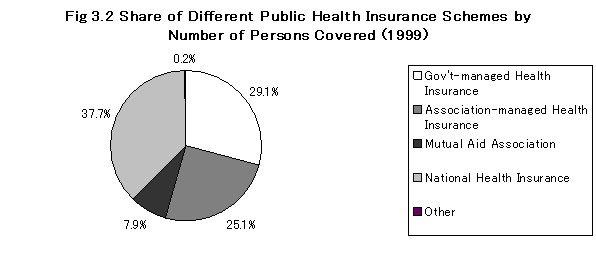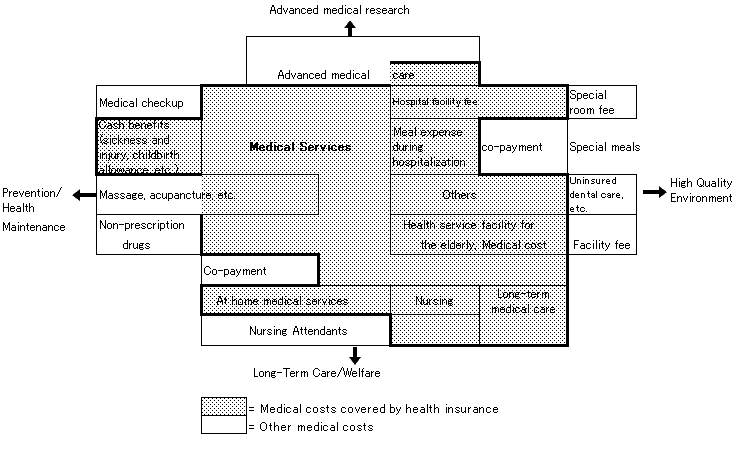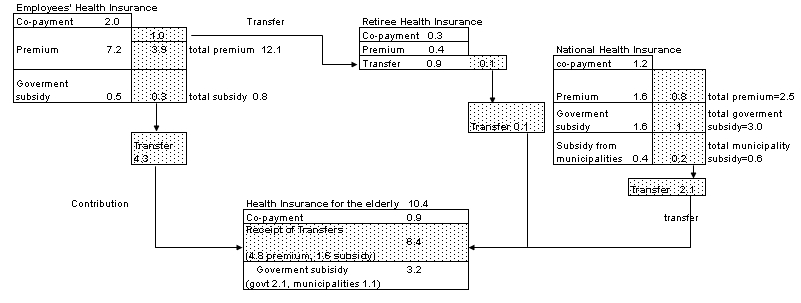
Japan's medical services are financed through a public mandatory health insurance system, which is composed of two types of schemes: occupation-based and region-based. The former is called the Health Insurance. Employers and employees of firms of a certain size and over form a health insurance society and thus these are called the Society-managed Health Insurance. There are nearly 1,800 such societies. For those who work at smaller firms, the government provides a collective health insurance, which is called the Government-managed Health Insurance. In addition, special professions such as civil servants, day laborers and seamen form separate nation-wide professional associations. These occupation-based public health insurances cover employees and their dependents. Those who are not covered by the Health Insurance are required to participate in a region-based health insurance, called the National Health Insurance, for which the municipalities (numbering more than 3,300) act as independent insurers. (See Fig 3.1) Mostly self-employed, farmers, workers of smaller firms and their family join the National Health Insurance, thus its participants more or less overlap those of the National Pension.

Hence, these public health insurances provide nearly universal coverage over the population. The share of each scheme is shown in Fig. 3.2. The Government-managed Health Insurance, the Association-managed Health Insurance, and the National Health Insurance each account for about one third of the total population.

Source: MHW Kose Hakusho (2002)
All the public health insurance schemes are financed by premiums, subsidy from the general budget of the government, and co-payment from patients. For the Health Insurance, the premium is a fixed percent of employee's salary, which is shared equally by the employers and the employees. For the National Health Insurance, the premium differs among local governments and is usually levied on the basis of income, property, and number of insured within a household. A substantial government subsidy is given to the National Health Insurance. For all Japanese medical insurance systems combined, the contribution by government subsidy, insurance premiums, and patient co-payment are 32.2%, 52.9%, 14.9%, respectively (1998).
3. Free to choose any medical facilityBecause Japanese health insurance systems are universal, there is no distinction between public and private hospitals from the viewpoint of the user. In fact, users are free to choose any medical service providers without constraint in terms of hospital type, location or other factors such as having referral or not.
4. Equal coverage of services at equal priceThe coverage of health insurance and the prices of medical services are standardized by law, and thus, all persons receive the same medical service at equal price. The area covered by the insurance is shown in Fig. 3.3.
Fig. 3.3 Medical Services Covered by Health Insurance

Source: MHW Kose Hakusho 2000
As the aging of the population proceeds, the share of the health care costs for the elderly in total medical costs has increased. However, because the composition of subscribers differs among insurance schemes, some insurance schemes, such as the National Health Insurance, have a larger number of elder subscribers than others and had to bear a bigger financial burden. To equalize the burden of the health care costs for the elderly among insurance schemes, a new system was introduced in 1983. Under the system, the health care costs for those aged 70 (See page 22 for details) and over in all schemes are separated from that for under age 70, and it is divided by all insurance schemes. One of the big component of the rising cost was the long-term care. To rectify this problem, the Government has introduced a mandatory Long-Term Care Insurance in April 2000.
People covered under this type of insurance are employees and their dependents. All employed persons are required to join the association, except those who are employed by private firms with less than five employees and self-employed. Depending on the occupation and size of employers, there exist several programs as described below.
(a) Society-managed Health InsuranceThis scheme is operated by health insurance societies organized by large firms for their employees. Sometimes more than one firms form a single society. Currently, there are 1,780 such associations (as of 1999).
(b) Government-managed Health InsuranceThis is for the employees of small and medium scale firms, which cannot form a health insurance society on its own. The Government provides a collective health insurance for them, with contributions from the employers and employees.
(c) Other Occupation-based health insuranceThe first two are operated by the Government, and the other three, by each mutual-aid associations.
2. National Health InsuranceThis scheme covers all those who are not covered by the Health Insurance, i.e. self-employed, farmers, students, and so forth. The insurers are municipalities in most cases, except for special professionals such as medical doctors who form National Health Insurance Societies on their own. Retirees who previously subscribed to the Health Insurance are insured under the National Health Insurance. However, the health care cost for the retirees of age 60-70 are financed by the transfer from the Employees' Health Insurance, i.e. retiree's former insurer.
The National Health Insurance is financed by the government subsidy as well as the insurance premiums collected from its subscribers on household basis. The premium amount differs from a municipality to another, and is based on both income and number of people who will be covered within the household. The premium can be discounted up to 60% for low-income households.
3. Health Service System for the ElderlyPreviously, health insurance for the elderly was covered under the National Health Insurance, except when they are financially dependent on their family and are covered by the Health Insurance of their family as their dependents. However, as a result of an increasingly aging population and rising cost, this arrangement led to an unbearably heavy burden on the National Health Insurance. Thus, a special program was created for those aged 70 and over, and for those between 65 and 70 years old who are bed-ridden or have severe disabilities. Under this program, the health care costs are mostly met by the subsidy from the central and local governments (30%) and the transfer of contributions from the National Health Insurance and the Health Insurance (70%) with minimal co-payments from the elderly. (See Fig 3.4)
Fig. 3.4 Sources of Financing in Health Insurance Schemes, 1998
(in trillions of yen )

Under the Health Insurance, the insured pays 20% of cost of all care, and dependents pay 30% of the cost (20% if inpatient). For both of them, the maximum of co-payment is 63,600 yen a month or the 22% of the average monthly salary, plus 1% of the cost over a certain amount for one illness. There are a lower threshold for low-income families and a higher threshold for the high-income families. Under the National Health Insurance, the insured pays 30% of medical costs. The maximum of co-payment is same as for the Employees' Health Insurance.
The co-payment for the elderly had been fixed low, but due to financial problems mentioned earlier, a reform was undertaken in 2000. Now, outpatients pay 10% of the cost of the drugs, as opposed to a rather low nominal fixed price before. The in-patients also bear 10% of the hospital fee, with a ceiling of up to \37,200 per month.
As mentioned earlier, Japan's public health insurance is going through a financial crisis. One of the main problems is the rising cost for the elderly. Some claim that to eradicate the problem entirely, the overall system of the Health Services for the Elderly must be overhauled. However, such a drastic reform is not politically feasible at the time. Some also argue that the insurers of the National Health Insurance (municipalities) should be merged together, so that financial risk is more shared among different insurers.
Meantime, Japan has been implementing a series of small reforms, keeping the current system mainly in tact. The most recent reform in 2002 raised the co-payment rate for both old and young generations. For those below 69 year old and who are in the Health Insurance, the co-payment rate was raised from 20 to 30% (Subscribers of the National Health Insurance already face 30% co-payment rate). The premium rate is also reformed to be applied to the entire annual salary, including bonuses. For those above 70 years old and above a certain income criteria, the co-payment rate is raised from 10 to 20%. The monthly upper limit of co-payment is also raised according to the income of the subscriber.
2. Health care cost for the elderlyThe share of health care costs for the elderly has risen continuously, reaching to about 34.6% of all medical costs (FY 2000). Since the contribution and co-payment of the elderly had been very limited, their medical costs are mainly met by the younger population's contributions in the health care system. However, due to rising medical costs and decreasing premiums caused by stagnant number of employees, many insurers in the Health Insurance Associations and the National Health Insurance have faced financial difficulties. More than a half (53.85% in 1998) of the Health Insurance schemes were in red, and it will be difficult for them to pay the required amount for the Health service for the Elderly, which takes up as much as 40% of their income from the premiums.
One of the reasons that the medical costs for the elderly are high is so called "the Social Hospitalization", meaning frail elderly are kept in hospitals for extended time of period, not necessarily because their conditions require medical attention in hospitals, but rather, they lack appropriate care at home or at a care facility. The introduction of the Long-Term Care Insurance in April 2000 was expected to reduce the high medical costs for such hospitalization by providing appropriate care at home and at lower-cost care facilities. The early result seems promising. The health care cost for the elderly in 2000 has declined significantly. It will be interest to see if this trend continues.
3. Reform of Drug PricingDrug tariff schedule sets the official price for each medicine on the basis of the weighted average of market price. Since a medical provider can obtain medicine at a bulk price which is lower than the official price, there exists an incentive for a medical provider to prescribe more medicine, and this is one of the reasons for high consumption of the drugs. A debate is on going to abate this incentive and to design a new system.
4. Reform of medical fee SystemUnder the current systems of fee-for-service payments, medical providers are paid, in principle, for whatever services and medicine they provide. Thus, there is an incentive for medical providers to over-examine and over-prescribe medicine, creating a tendency to higher medical costs. In addition, there has been a gradual shift from acute to chronic diseases. This has led to a debate on a reform of the fee schedule to fixed prospective payments so that doctors are paid a fixed amount depending on the type and severity of the disease, sometimes called DRG (Diagnosis Related Groups) method. This system has been experimentally introduced to about 10 hospitals.